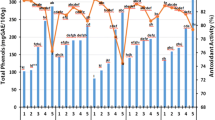Abstract
Phenolic compounds, antioxidant activities and total phenolic contents of leaves from different olive varieties (Gemlik, Kalamata, Yağlık and Sarıulak) were evaluated after conventional drying at different temperatures (50, 60, 70 and 80 °C). The drying process resulted in non-significant effects on olive leaves. The phenolic contents however, varied with drying temperature. The contents of minor total phenolics in Gemlik, Kalamata and Sarıulak leaves were 1457.6, 1899.3 and 2179.8 mg GAE/100 g, respectively when dried at 60 °C. The highest total phenolic reduction (23.2%) was observed in Kalamata leaves after drying at 80 °C. The major phenolic compounds in olive leaves were gallic acid (101.2–439.7 mg/100 g), 3,4-dihydroxybenzoic acid (66.7–460.4 mg/100 g), (+)-catechin (39.2–667.8 mg/100 g), 1,2-dihydroxybenzene (15.8–584.8 mg/100 g) and quercetin (33.1–277.7 mg/100 g). It was observed that olive leaves from different varieties are rich in phenolic compounds which are sensitive to heat and varied with drying temperature.

Similar content being viewed by others
References
Abaza L, Taamalli A, Nsir H, Zarrouk M (2015) Olive tree (Olea europeae L.) leaves: importance and advances in the analysis of phenolic compounds. Antioxidants 4:682–698
Ahmad-Qasem MH, Barrajón-Catalán E, Micol V, Mulet A, García-Pérez JV (2013) Influence of freezing and dehydration of olive leaves (var. Serrana) on extract composition and antioxidant potential. Food Res Int 50:189–196
Ansari M, Kazemipourb M, Fathib S (2011) Development of a simple green extraction procedure and HPLC method for determination of oleuropein inolive leaf extract applied to a multi-source comparative study. J Iran Chem Soc 8:38–47
Boudhrioua N, Bahloul N, Slimen IB, Kechaou N (2009) Comparison on the total phenol contents and the color of fresh and infrared dried olive leaves. Ind Crops Prod 29:412–419
Ghafoor K, Al-Juhaimi FY, Choi YH (2012) Supercritical fluid extraction of phenolic compounds and antioxidants from grape (Vitis labrusca B.) seeds. Plant Foods Hum Nutr 2012(67):407–414
Guinda A, Castellano JM, Santos-Lozano JM, Delgado-Hervas T, Gutierrez-Adanez P, Rada M (2015) Determination of major bioactive compounds from olive leaf. LWT Food Sci Technol 64:431–438
Kamran M, Hamlin AS, Scott CJ, Obied HK (2015) Drying at high temperature for a short time maximizes the recovery of olive leaf biophenols. Ind Crops Prod 78:29–38
Lee SK, Mbwambo ZH, Chung HS, Luyengi L, Games EJC, Mehta RG (1998) Evaluation of the antioxidant potential of natural products. Comb Chem High Throughput Screen 1:35–46
Lee OH, Lee BY, Lee J, Lee HB, Son JY, Park CS, Shetty K, Kim YC (2009) Assessment of phenolics-enriched extract and fractions of olive leaves and their antioxidant activities. Biores Technol 100:6107–6113
Parmar N, Singh N, Kaur A, Thakur S (2017) Comparison of color, anti-nutritional factors, minerals, phenolic profile and protein digestibility between hard-to-cook and easy-to-cook grains from different kidney bean (Phaseolus vulgaris) accessions. J Food Sci Technol 54(4):1023–1034
Püskülcü H, İkiz F (1989) Introduction to Statistic. Bilgehan Press, Bornova İzmir, p 333 (in Turkish)
Rahmaniana N, Jafaric SM, Wani TA (2015) Bioactive profile, dehydration, extraction and application of the bioactive components of olive leaves. Trends Food Sci Technol 42:150–172
Ranalli A, Contento S, Lucera L, Di Febo M, Marchegiani D, Di Fonzo V (2005) Factors affecting the contents of iridoid oleuropein in olive leaves (Olea europaea L.). J Agric Food Chem 54:434–440
Romani A, Mulas S, Heimler D (2017) Polyphenols and secoiridoids in raw material (Olea europaea L. leaves) and commercial food supplements. Eur Food Res Technol 243:429–435
Ryan D, Antolovich M, Herlt T, Prenzler PD, Lavee S, Robards K (2002) Identification of phenolic compounds in tissues of the novel olive cultivarhardy’s mammoth. J Agric Food Chem 50:6716–6724
Silva S, Gomes L, Leitão F, Coelho AV, Vilas Boas L (2006) Phenolic compounds and antioxidant activity of Olea europaea L. fruits and leaves. Food Sci Technol Int 12(5):385–396
Tabera J, Guinda A, Ruiz-Rodríguez A, Señoráns JF, Ibáñez E, Albi T (2004) Countercurrent supercritical fluid extraction and fractionation of high-added-value compounds from a hexane extract of olive leaves. J Agric Food Chem 52:4774–4779
Talhaoui N, Gomez-Caravana AM, Leon L, De la Rosa R, Segura-Carretero A, Fernandez-Gutierrez A (2014) Determination of phenolic compounds of ‘Sikitita’ olive leaves by HPLC-DAD-TOF-Ms. Comparison with its parents ‘Arbequina’ and ‘Picual’ olive leaves. LWT Food Sci Technol 58:28–34
Tayoub G, Sulaiman H, Hassan AH, Alorfi M (2012) Determination of oleuropein in leaves and fruits of some Syrian olive varieties. Int J Med Aromat Plants 2:428–433
Yoo KM, Lee KW, Park JB, Lee HJ, Hwang IK (2004) Variation in major antioxidants and total antioxidant activity of Yuzu (Citrus junos SiebexTanaka) during maturation and between cultivars. J Agric Food Chem 52:5907–5913
Acknowledgements
The authors would like to extend their sincere appreciation to the Deanship of Scientific Research at King Saud University for its funding the Research Group No. (RG-1435-049).
Author information
Authors and Affiliations
Corresponding author
Ethics declarations
Conflict of interest
No potential conflict of interest was reported by the authors.
Rights and permissions
About this article
Cite this article
Al Juhaimi, F., Özcan, M.M., Uslu, N. et al. The effects of conventional heating on phenolic compounds and antioxidant activities of olive leaves. J Food Sci Technol 55, 4204–4211 (2018). https://doi.org/10.1007/s13197-018-3356-y
Revised:
Accepted:
Published:
Issue Date:
DOI: https://doi.org/10.1007/s13197-018-3356-y




